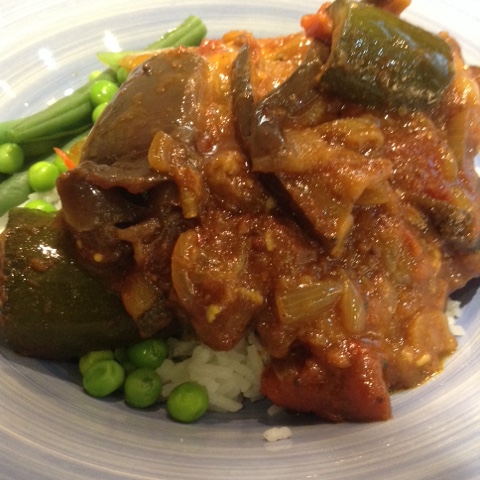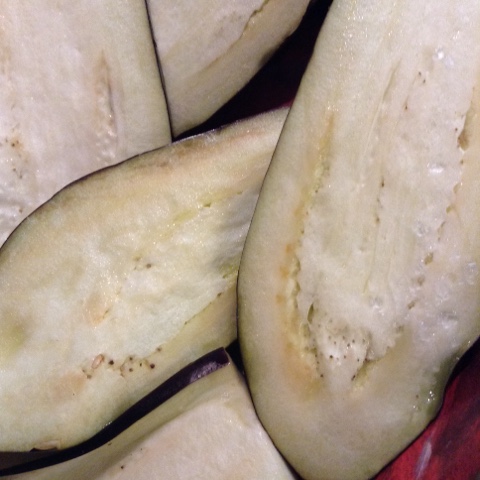Last summer we visited relatives in Greece. When we arrived, Milly had cooked us a delicious pastitsio - a traditional Greek pasta bake, with layers of tomato sauce, cheese sauce and pasta, quite a lot like a lasagne but using a pasta similar to macaroni. Unfortunately, Milly didn't know that veggie daughter didn't eat meat, so the pastitsio contained beef, but veggie daughter was hungry after our long journey and managed to eat around the meat layer, finding out in the process that pastitsio is a wonderful thing.
Fast forward to a cool spring day in the UK and veggie daughter and I find ourselves craving that delectable feast (along with the Greek sunshine that went with it). I looked up recipes, wondering how I can feel so hungry for the flavours of pastitsio at 10 in the morning. Many of the traditional recipes have cinnamon and allspice in them. I'm not a huge fan of cinnamon in savoury dishes and one recipe I found said that cinnamon absolutely does not belong in traditional pastitsio. I took that as permission to leave it out! I don't remember Milly's tasting particularly of cinnamon; the meat layer was more like the beef sauce layer of an Italian lasagne; lots of tomato, garlic, and probably oregano. A lot of the recipes said to put oil and parmesan or an authentic Greek cheese called Kefalotyri (which I've never tried but would like to) into the pasta layer. I ended up using halloumi, as I had a pack open in the fridge that needed using up. Some recipes added beaten egg to the white sauce. Some separated the egg, adding the whites to the pasta layer, and the yolk to the white sauce.
The type of pasta to use is the source of much debate, with some saying it must be ziti or some other traditional Greek type and others saying that penne or pretty much any type of macaroni will do. A lot of the recipes show the pasta very carefully and evenly laid across the dish to make a beautiful pattern when the pastitsio is served. It looked like too much effort for a lazy cook like me. I used macaroni, layered as it fell rather than artfully arranged. Most of the recipes suggested using beef, some lamb, but obviously I needed a veggie alternative. I found some versions using lentils and some with varying combinations of mixed vegetables, and then I came across this recipe
for soy pastitsio on a great website called vegetarian underground. So thanking Sally K for that recipe, I unearthed the savoury soya protein mince from the back of the cupboard and assembled the rest of my ingredients. I did make quite a few changes to the original recipe, mainly based on what I'd read on other sites and on what I remembered of Milly's pastitsio.
One layer of Sally's pastitsio that intrigued me was the silken tofu - I think it could probably be omitted, but I must admit that it did keep the dish nice and moist and the herbs in it added to the flavour. I happened to have a couple of cartons of silken tofu in the cupboard and welcomed the opportunity to use it - I'm never really sure what to do with it. Anyway, my recipe is below. It was a hit with veggie daughter and the meat eaters alike. It did take longer than I had planned to assemble, so by the time I got it into the oven we were ravenous. We ended up taking it out of the oven a bit earlier than I would have liked, but it still tasted great. Most people say you should leave it to rest after it comes out of the oven, and eat it lukewarm, as you get a nicely shaped firm portion, but we just couldn't wait...
 |
| The soya mince a-soaking - it does not smell very appetising at this stage, but don't be put off... |

 |
| Silken tofu and herbs |
Soya Mince Pastitsio (serves 6)
For the mince layer:
200g dried soya mince (TVP)
600ml cold water
4 tbsp olive oil
2 yellow onions, finely chopped
4 cloves garlic, minced
2 tsp dried oregano
1 tsp dried basil
1 tsp smoked paprika
1/2 tsp allspice powder
2 tsp paprika powder
salt and pepper
1 tin tomatoes (chopped)
1 carton passata
a good squeeze of tomato puree
dash of balsamic vinegar or red wine (I only had balsamic)
1 bay leaf
For the pasta layer:
500g macaroni or similar pasta
salt
olive oil
1 tbsp grated halloumi
For the tofu layer:
1 carton (350g) silken tofu
handful of fresh basil and parsley
1 small clove garlic
50g grated halloumi
salt and freshly ground black pepper
For the white sauce:
2 tbsp butter
2 tbsp plain flour
about 500ml milk (I added some cream that needed using up)
250g grated halloumi
50g grated halloumi to sprinkle over the top
freshly grated nutmeg
1. Prepare the mince layer:
- Put the soya mince a large bowl, pour over the water and stir in the olive oil. Leave to absorb for about 30 minutes or so.
- Gently saute the onion, garlic, dried herbs and spices in a good glug of olive oil.
- Add the soya mince and stir to combine with the onion and garlic mixture.
- Add the tin of tomatoes, passata, tomato puree, balsamic vinegar, bay leaf and seasoning and bring to the boil. Simmer for a few minutes until most of the liquid has evaporated or been absorbed into the mince.
- Take off the heat and set aside to cool slightly.
2. Prepare the pasta layer:
- Cook the pasta in boiling salted water for 2 minutes less than the correct cooking time (it should still be firm.
- Drain and stir in a tablespoon of olive oil to stop it sticking together, along with a tablespoon of halloumi cheese and set aside to cool.
 |
| Herby silken tofu layer |
3. Prepare the tofu layer:
- Wash the herbs and discard tough stems.
- Peel the garlic clove.
- Put the tofu, herbs, garlic, halloumi into a blender and season with black pepper.
- Blend until smooth.
4. Prepare the white sauce:
- Melt the butter in a large heavy based pan.
- Stir in the flour, combining it with the butter to make a smooth paste.
- Gradually add the milk, stirring all the time to combine. Keep stirring as the sauce thickens to avoid lumps forming.
- Remove from the heat and stir in the grated cheese.
 |
| Smooth creamy cheese sauce |
- Once it has cooled slightly add the beaten egg and beat it in (you don't want it to be too hot or the egg will scramble).
5. Assemble and bake the pastitsio:
- Preheat the oven to 200 degrees centigrade.
- In a large oven proof dish (about 2 inches tall, about 12 x 9 inches base) put a layer of soya mince sauce (aim to use about a third of the sauce in this layer).
- Top with half the macaroni, pressing it down quite firmly (you don't want gaps)
- Spread over half the tofu sauce.
- Use another third of the mince sauce for the next layer.
- Add the rest of the macaroni and press down firmly
- Use the rest of the tofu sauce over the top of the macaroni.
- For the next layer add the rest of the meat sauce.
- Top the whole thing with the cheese sauce, smoothing it out evenly.
- Sprinkle with grated cheese and grated nutmeg.
- Bake uncovered for about 35 minutes, until golden brown and bubbling. (Stand the dish on a baking sheet if you have overfilled it like I did, otherwise you will be in for an oven cleaning session.)
- If you can bear it, leave to rest for at least 15 minutes before serving (purists say pastitsio should be cooked the day before eating; certainly the leftovers were amazing the next day).
- Serve with some green veggies or salad.






































